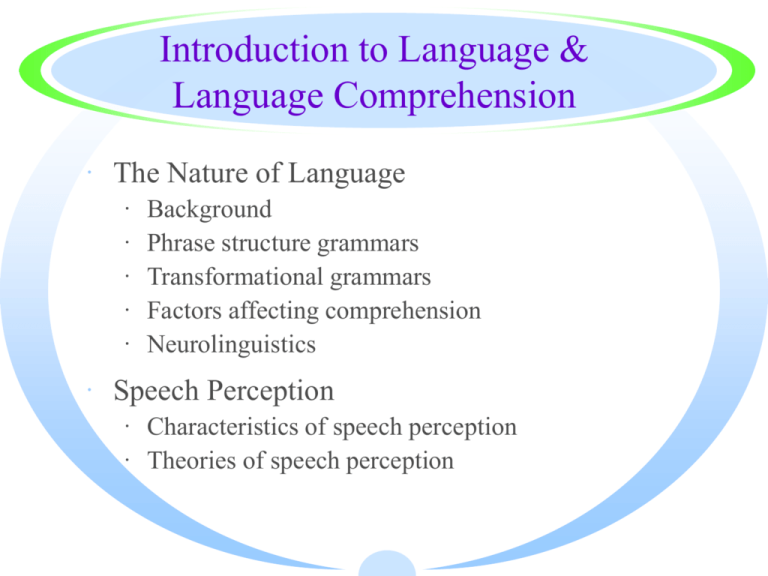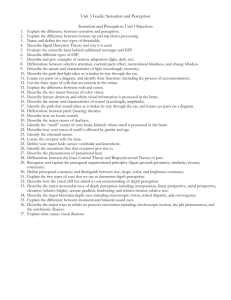Language Comprehension
advertisement

Introduction to Language & Language Comprehension · The Nature of Language · · · · · Background Phrase structure grammars Transformational grammars Factors affecting comprehension Neurolinguistics · Speech Perception · Characteristics of speech perception · Theories of speech perception Introduction to Language & Language Comprehension · Basic Reading Processes · · · · Perceptual processes in reading Discovering the meaning of an unfamiliar word Reading and working memory Theories about the role of sound in word recognition · Understanding Discourse · Forming a coherent representation of the text · In depth: Inferences in reading · Artificial intelligence and reading Language · 75,000 - 100,000 words · Productive or generative nature of language · Psycholinguistics Nature of Language · Phoneme · Morpheme · Semantics · Syntax · Pragmatics Phrase Structure Grammars · Sentence decomposed into constituents by rewrite rules · “The young woman carried the heavy painting.” · Phrase structure rules · Why is this important? Transformational Grammar · Chomsky · Surface Structure vs. Deep Structure · Rules / Grammar that converts Deep Structure to Surface Structure · Deep Structure = more abstract meaning (structure) of sentence Different surface structures but same deep structure: Sue corrected the homework. The homework was corrected by Sue. or: The boy kissed the girl. The girl was kissed by the boy. Was the girl kissed by the boy? Same surface structure but different deep structures: Visiting relatives can be a nuisance. or The shooting of the hunters was terrible. Factors Affecting Comprehension · Negatives – e.g., Clark & Chase (1972) · Passive vs. Active Voice · Ambiguous Sentences Clark & Chase (1972) * + 1. ‘Star’ is above ‘plus’. Y/N ? 2. ‘Plus’ isn’t above ‘star’. Y/N ? Positive vs. -faster -fewer errors Negative -slower -more errors Passive vs. Active · Chomsky · Active sentences 7 times more frequent · Implications for writing: · “The study was run by three researchers” · “Three researchers ran the study” Even a single word in a normal sentence can be ambiguous: “The bank was washed away by the flood.” “The bank was washed every morning before it opened.” vs. “Pat took the money to the bank before it closed at 5:00.’ Neurolinguistics · Brain & Language · Aphasia · Broca’s Aphasia · Wernicke’s Aphasia · Recent Neuroscience Research · PET scans · ERPs Hemisphere Specialization · · · · Language localized in Left Hemisphere? Yes / No Left-Handers (50%) -------> process in RH or Right-Handers (5%) both hemispheres LH dominance: · · · · · speech perception complex words – morphemic analysis Syntax Reading RH participates in language production · Interprets emotional tone · Metaphor · Subtle word meanings · Deaf individuals · Broca’s Aphasia · “Yes . . . Monday . . . Dad and Dick . . . Wednesday nine o’clock . . .ten o’clock doctors . . . and . . .teeth.” (Geschwind, 1980) · Wernicke’s Aphasia · “Mother is away here working her work to get her better, but when she’s looking the two boys looking in the other part. She’s working another time.” (Geschwind, 1980) Tasks · 1st Level - subject looks at ‘+’ · 2nd Level a. Visual Task - subject looks at a word (e.g., ‘hammer’) b. Auditory Task - subject hears a word (e.g., ‘hammer’) · 3rd Level - subject speaks / says the word (e.g., ‘hammer’) · 4th Level - subject provides / says a word (verb) that describes / corresponds to function Speech Perception · 15 – 25 sounds/sec · Characteristics of Speech · · · · Variability Context allows fill in Visual cues - McGurk Effect Boundaries · Theories of Speech Perception · Speech is special - phonetic module · General Mechanism Approach Warren and Warren (1970) · It was found that the *eel was on the axle. · It was found that the *eel was on the shoe. · It was found that the *eel was on the orange. · It was found that the *eel was on the table. McGurk & McDonald (1976) QuickTi me™ and a S orenson V ideo decompressor are needed t o see thi s pi cture. What’s going on ? 1. Lip movement = “ga” 2. Sound recorded = “ba” 3. You hear = “da” Perceptual Processes in Reading · Saccades · Fixations · Moving window technique · Perceptual span · 4 letters to left · 15 letters to right Saccadic Eye Movements Predictable Patterns · No fixations on blank spaces · Jumps over short words, function words (e.g., ‘the’ and ‘of’) and predictable words · Misspelled or unusual words · Good readers · larger jumps / fewer regressions · shorter fixations Eye movement patterns for a good reader (top numbers) and a poor reader (bottom numbers). “At dawn the blen arose on the horizon and shone brightly.” Context Clues – Sternberg & Powell · Temporal cues indicate how often X (unknown word) occurs or how long it lasts · Spatial cues identify X’s location · Value cues suggest the emotion that X arouses · Functional descriptive cues describe the possible actions X can perform · Stative descriptive cues concern the physical properties of X (that is its physical state) Theories About Word Recognition 1. Direct - Access Hypothesis “televison” 2. Phonologically Mediated Hypothesis “televison” 3. tel - e - vizun Dual Route Hypothesis “television” tel - e - vy - zun Direct Access Hypothesis Evidence · Homonyms read - reed sea - see · Bradshaw & Nettleton (1974) mown - down horse - worse quart - part · Deep dyslexia Evidence for Phonological-Mediation · Sounding out difficult material ‘insouciant’ ‘pullulate’ · Children vs. Adults? · Other evidence · Van Orden (1987) - categorizing homonyms flowers rose rows · Luo (1998) Lion-Bare vs Lion-Bean (related or unrelated? > errors Dual-Route Hypothesis Evidence · Flexibility · Individual Differences · Word Characteristics · Difficulty of words · Unfamiliar vs. familiar · Stress Implications for Teaching Reading · Whole-word approach · Phonics vs. phonemic awareness








